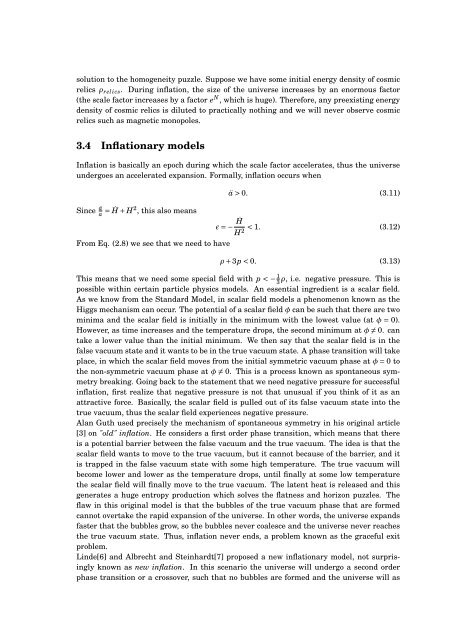Master's Thesis in Theoretical Physics - Universiteit Utrecht
Master's Thesis in Theoretical Physics - Universiteit Utrecht
Master's Thesis in Theoretical Physics - Universiteit Utrecht
You also want an ePaper? Increase the reach of your titles
YUMPU automatically turns print PDFs into web optimized ePapers that Google loves.
solution to the homogeneity puzzle. Suppose we have some <strong>in</strong>itial energy density of cosmicrelics ρ relics . Dur<strong>in</strong>g <strong>in</strong>flation, the size of the universe <strong>in</strong>creases by an enormous factor(the scale factor <strong>in</strong>creases by a factor e N , which is huge). Therefore, any preexist<strong>in</strong>g energydensity of cosmic relics is diluted to practically noth<strong>in</strong>g and we will never observe cosmicrelics such as magnetic monopoles.3.4 Inflationary modelsInflation is basically an epoch dur<strong>in</strong>g which the scale factor accelerates, thus the universeundergoes an accelerated expansion. Formally, <strong>in</strong>flation occurs whenS<strong>in</strong>ce äa = Ḣ + H2 , this also meansä > 0. (3.11)ɛ = − Ḣ < 1. (3.12)H2 From Eq. (2.8) we see that we need to haveρ + 3p < 0. (3.13)This means that we need some special field with p < − 1 3ρ, i.e. negative pressure. This ispossible with<strong>in</strong> certa<strong>in</strong> particle physics models. An essential <strong>in</strong>gredient is a scalar field.As we know from the Standard Model, <strong>in</strong> scalar field models a phenomenon known as theHiggs mechanism can occur. The potential of a scalar field φ can be such that there are twom<strong>in</strong>ima and the scalar field is <strong>in</strong>itially <strong>in</strong> the m<strong>in</strong>imum with the lowest value (at φ = 0).However, as time <strong>in</strong>creases and the temperature drops, the second m<strong>in</strong>imum at φ ≠ 0. cantake a lower value than the <strong>in</strong>itial m<strong>in</strong>imum. We then say that the scalar field is <strong>in</strong> thefalse vacuum state and it wants to be <strong>in</strong> the true vacuum state. A phase transition will takeplace, <strong>in</strong> which the scalar field moves from the <strong>in</strong>itial symmetric vacuum phase at φ = 0 tothe non-symmetric vacuum phase at φ ≠ 0. This is a process known as spontaneous symmetrybreak<strong>in</strong>g. Go<strong>in</strong>g back to the statement that we need negative pressure for successful<strong>in</strong>flation, first realize that negative pressure is not that unusual if you th<strong>in</strong>k of it as anattractive force. Basically, the scalar field is pulled out of its false vacuum state <strong>in</strong>to thetrue vacuum, thus the scalar field experiences negative pressure.Alan Guth used precisely the mechanism of spontaneous symmetry <strong>in</strong> his orig<strong>in</strong>al article[3] on "old" <strong>in</strong>flation. He considers a first order phase transition, which means that thereis a potential barrier between the false vacuum and the true vacuum. The idea is that thescalar field wants to move to the true vacuum, but it cannot because of the barrier, and itis trapped <strong>in</strong> the false vacuum state with some high temperature. The true vacuum willbecome lower and lower as the temperature drops, until f<strong>in</strong>ally at some low temperaturethe scalar field will f<strong>in</strong>ally move to the true vacuum. The latent heat is released and thisgenerates a huge entropy production which solves the flatness and horizon puzzles. Theflaw <strong>in</strong> this orig<strong>in</strong>al model is that the bubbles of the true vacuum phase that are formedcannot overtake the rapid expansion of the universe. In other words, the universe expandsfaster that the bubbles grow, so the bubbles never coalesce and the universe never reachesthe true vacuum state. Thus, <strong>in</strong>flation never ends, a problem known as the graceful exitproblem.L<strong>in</strong>de[6] and Albrecht and Ste<strong>in</strong>hardt[7] proposed a new <strong>in</strong>flationary model, not surpris<strong>in</strong>glyknown as new <strong>in</strong>flation. In this scenario the universe will undergo a second orderphase transition or a crossover, such that no bubbles are formed and the universe will as
















